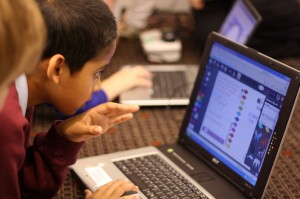Game-Based Learning
The game-based learning movement in education seeks to integrate the active and critical learning required for effective instructional design, with the active and critical intellectual and emotional engagement seen in effective game design. If teachers can combine the entertainment value of well-designed games with the rich content of lessons, then the hope is that students will not only learn, but enjoy learning and enjoy applying their new knowledge in the 21st century.
History
Teachers have always sought new and exciting ways to provide content to their students. Although a movement in game-based learning is still two-three years away from current mainstream classrooms, educational games, in some form, have been used in classrooms since the 1960s (Dempsey et al., 1997). The Back to Basics movement in the 1970s almost completely eliminated all use of games in the classroom; however “with the proliferation of computers in the 1980s, the use of educational games in the classroom became popular with titles that included Oregon Trail, Math Blaster, and Number Munchers” (Serious games, 2012). Unfortunately, many of these games offered no educational content and were seen as “time-fillers” for students who finish their work early, or as a reward system.
In 2002, the “serious game movement” sought to create games that prepared the player for a particular environment or situation. The United States Military was the primary consumer of these types of games wanting their personnel to “understand their surroundings, be able to communicate, use new technologies and quickly make decisions” (Klopfer, 2008).
Alternate Reality Games (ARG) and Massive Multi-player Online Games (MMO) came unto the gaming market in the early 2000s and simulate real-world experiences and provide a key social component. However, the first things these games do are “create an emotionally compelling context for the player” (Squire, 2008, p. 17). Once students are engaged, they provide goals and immediate performance feedback. When players play, they do not fear losing or failing. It is a safer system for students to experiment and take these risks.
Game Theory
James Paul Gee (2007) describes video games (and gaming in general) as having its own literacy. “When people learn to play video games, they are learning a new literacy (p. 17). Literacy means something different for different texts and situation. Images hold meaning as well as text. Language is not only about reading and writing words. Gee (2007) argues that video games contain semiotic domains because they “recruit one or more modality (e.g., oral or written language, images, equations, symbols, sounds, gestures, graphs, artifacts, etc.) to communicate distinctive types of meaning.” By playing games, one is always learning something. Therefore, proponents of game-based learning see great potential in explicitly incorporating educational content into a video game.
Current Issues in Game-Based Learning
Despite the increased interest in educational game-based learning, there still remains a lack of high-quality educational games that integrate both educational and game design principles. Teachers are often stuck with poorly-constructed games that appear educational, but are merely poor-quality video games. As with any resource, it is important for educators to find the best examples for use in their classroom. One should not expect to pick a random game from the shelf and give it to their students, and then expect learning to take place. Instead, teachers need to find games that are related to the curriculum. Effective game-based learning gives students an environment that allows them to work toward a goal, choose actions related to that goal, and make mistakes (see Juul’s classic game model). The game environment (for video games: the virtual environment) needs to be authentic in order to draw the student into the game. Students need to see and understand the connection between the learning experience and its real-world context. Games, similar to learning, should be an active experience, not a passive set of drills and memorization.
Luckily, instructional designers and game designers are beginning to work together to solve this problem. They are finding a common vocabulary, which allows for collaborative work and produces games that meet the needs of effective games and instruction.
Another major problem is cost. Currently, high-quality video games have huge budgets. For example, The Halo franchise was given an unlimited budget to create and release the much-anticipated Halo 3. They spent upwards of $50 million to create the game. Microsoft spent around $200 million to market the game. Now, I do not propose that educators look at spending exorbitant amounts of money to create a “fun” way to learn concepts. It is just not possible. Even if money like that were available, it would be best spent on teacher’s salaries, instead of game resources.
Teachers need to take advantage of the many free online games available; but more importantly, teachers need to examine traditional board and card games. All games, from simple Solitaire to a complicated video game like Halo, follow the same basic game design and MDA framework. If teachers examine how a game is set-up, they can begin to see how they can best modify the game design to fit the needs of their classroom or content area.
Teacher Resources
Andrew Miller Edutopia Article
- Brief article on game-based learning as an emerging trend in education. Included links.
Amy Erin Borovoy Edutopia 5-Minute Film Festival: Games-Based Learning
- Collection of videos showcasing the game-based learning movement.
Aneesh Bhat Upside of Learning Blog
- Links to three game-based learning sites
References
Dempsey, J.V., Lucassen, B.A., Haynes, L.L, & Casey, M. S. (1997). An exploratory study of forty computer games (COE Technical Report No. 97-2). Mobile, AL: University of South Alabama.
Gee, J. P. (2007). What video games have to teach us about learning and literacy. (Revised and updated ed.). New york, NY: Palgrave MacMillan.
Klopfer E. Augmented learning: Research and design of mobile educational games [e-book]. MIT Press; 2008. Available from: eBook Collection, Ipswich, MA. Accessed July 26, 2011.
Serious game. (n.d.). In Wikipedia. Retrieved July 19, 2012, from http://en.wikipedia.org/wiki/Serious_game
Squire, K. (2008). Video game-based learning: An emerging paradigm for instruction. Performance Improvement Quarterly, 21(2), 7-36.

